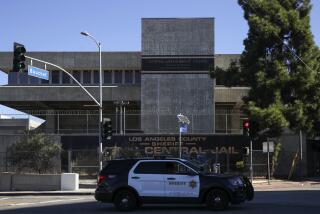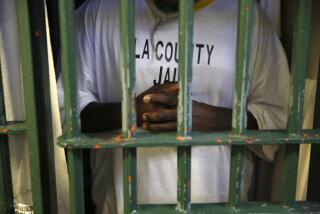L.A. County Inmates Facing 33 Days Now Serve Only 1
LOS ANGELES — Convicted criminals sentenced to 33 days or less in jail in Los Angeles County now actually spend only 1 day in custody because of severe overcrowding, sheriff’s officials have revealed.
Assistant Sheriff Dick Foreman said that the Sheriff’s Department, which runs the county’s jails, has had to free the criminals early to comply with a federal judge’s order to control the jail population.
The early releases began in May, at first with inmates sentenced to 10 days being freed in one day. But the number of days chopped off sentences has been periodically increased. It hit the level of one day in jail for a 30-day sentence several months ago, officials said, and last week hit the level of one day for 33 days for men.
Foreman, who is in charge of all county jails, said that now, when a judge tells a convicted misdemeanant, “$500 or 30 days in jail, the wise defendant says I’ll take the 30 days because he knows he’s going to do one (day).
“This is not a solution,” he said of the early releases. “It’s supposed to be an emergency stopgap measure. It’s not something the sheriff . . . wants to continue.”
So far, about 86,000 inmates have been freed early, and Foreman said he expects to pass the 100,000 mark this spring. The county’s jails can lawfully hold 22,000 inmates at a time.
To keep from exceeding that level, the Sheriff’s Department has so far freed only two classes of inmates. One group includes accused criminals in jail only because they cannot afford to post bails of $2,500 or less, who are released on their own promise to appear in court. The other group includes inmates convicted of misdemeanors--a class of relatively minor crimes ranging from petty theft to some assaults to carrying a concealed weapon.
However, Foreman said, early release of people accused of more serious crimes may be necessary soon.
Foreman said the department is reluctantly considering the release of inmates accused of nonviolent felonies who have waited more than 60 days for trials while their cases are pending in Superior Court.
He said Sheriff Sherman Block notified Municipal and Superior Court judges of this contingency plan in letters mailed last Friday.
Sheriff’s officials said there is no timetable for the release of accused felons.
“It’s something we hope never comes to pass,” said Cmdr. Jim Callas, the sheriff’s official who is in charge of Men’s Central Jail, Sybil Brand Institute, the county’s jail for women, and the Inmate Reception Center, where most new inmates are processed and from which inmates are discharged.
Last week, still struggling to meet the court order, Callas said, the Sheriff’s Department began taking an additional 3 days off the sentences of male inmates. That means men sentenced to 33 days are now out in 1, he said. Because the women’s jail is slightly less crowded, the 3 additional days off were not applied to women prisoners.
Callas said the department is preparing to take as many as 5 more days off the sentences of convicted male misdemeanants to stay within the court-ordered population cap.
Most sentenced misdemeanants are taken from court to the reception center, which is next to Men’s Central Jail, Callas said. There they are booked, which includes fingerprinting and a photograph. As paper work on their cases is completed, sheriff’s personnel check for outstanding warrants and parole holds. If none is found, the inmates are released. Some never make it to the jail, and some never even surrender their civilian clothes.
The booking and release process takes 12 to 24 hours, depending on the number of prisoners, Callas said.
Asked if it makes economic sense to bother processing inmates so that they can be immediately discharged, Callas responded: “Lots of different kinds of senses--economic and common--aren’t necessarily compatible with the situation we find ourselves in. We’re doing some very distasteful things out of necessity. It’s a sad situation--a very difficult one to deal with.”
John Mayeda, assistant presiding judge of the Los Angeles Municipal Court, concurred.
“I don’t believe there’s anybody sitting on this court who’s pleased with this situation,” he said. “It reflects negatively on the authority of the court and on respect for the court when sentences are handed down that cannot be served. We are aware, though, that the sheriff and other law enforcement agencies are doing everything they can to alleviate the problem. It’s a very difficult problem. I don’t believe there is a simple solution.”
The Sheriff’s Department was granted the authority for the early releases by U.S. District Judge William P. Gray, who presided over a jail overcrowding lawsuit against the department which was won by the American Civil Liberties Union of Southern California in 1979.
In recent years, the ACLU and the Sheriff’s Department have worked cooperatively on the jail overcrowding problem, which officials of both agencies perceive to be caused in part by delays in Superior Court. These delays have resulted in accused felons spending long periods--in some cases, years--in county jails while awaiting trial.
However, Richard P. Byrne, presiding judge of Los Angeles Superior Court, has said his court is being made a “convenient scapegoat.” He said last fall that the number of accused or convicted felons in county jails while their cases are being processed by the court had decreased substantially in the last three years, while the jail population had increased.
More to Read
Sign up for Essential California
The most important California stories and recommendations in your inbox every morning.
You may occasionally receive promotional content from the Los Angeles Times.









